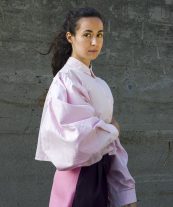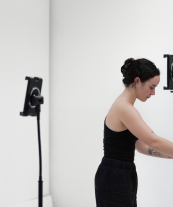COMMON GROUNDS: Audrey Large x Ginevra Petrozzi
 1
1
 2
2
— ‘What is the machine doing and what is the artist doing?’
Audrey Large is a designer who truly works at the intersection of the digital and physical worlds. When she won the Young Designer Award in 2021, the jury was intrigued by her work, unable to determine whether her visuals were digital renders or photos of physical sculptures. Audrey spotlights Ginevra Petrozzi, who employs witchcraft and rituals as an antidote to technological surveillance.
Audrey and Ginevra have moved in tandem: Both studied at the Design Academy Eindhoven and later at the Jan van Eyck, though a few years apart. Here, they discuss their methodologies, the intent behind their work, and what they see as magic in design.
Human, digital or magical?
Ginevra: “When I arrived in Eindhoven in 2019, I was already familiar with Audrey’s work and was mesmerized by it. I loved the precision and the high aesthetic quality, but most of all, the process through which digital objects are transformed and brought into the physical world. Audrey’s sculptures seem almost supernatural, you’re drawn to their uncanniness, their mystic quality. They make me wonder: what is the machine doing and what is the artist doing?”’
Audrey: “I see many similarities in our work. I believe that when I draw digitally and shape this digital material, I also infuse it with emotion. For me, the material outcome is inherently digital because it was made as a digital file. Yet, I still consider the work to be very much created by the human hand. What I admire about Ginevra’s work is the way she ties the magical and spiritual to the machine, through performance and material experimentation, highlighting the space between the digital and the human.
Ginevra: “I’m fascinated by the merging of magic and technology. Humans have always sought answers in the world around them, through magical thinking and seeking and interpreting signs. In the age of big data, it might seem impossible now, but I argue that our current reality is akin to living in a ‘magic reality system’. Now, we just apply magical thinking to technology.”
Finding the method
Audrey: “During graduation I felt a bit lost. Other students would start with physical matter and be encouraged to go into the workshop, but I couldn’t relate to that process, because I’m not really a traditional ‘maker’. But I do have an affinity for drawing and image-making, so I began looking into how visual effects in films were made. Very organically I began to formulate my method: to build objects the same way we build digital images. I found a way to translate it into my own visual language.”
Ginevra: “Feeling lost during graduation is a common experience. I spent three months just reading tarots. One day I noticed a card next to my phone, and it struck me that they had the same dimensions and visual traits. Tarot is about self-reflection and recognizing symbols and patterns, to rewrite one’s future. In the context of algorithms, this suddenly made sense to me, because algorithms have become quasi-magical entities for predicting and programming our future. For my graduation project, I performed as ‘the fortuneteller’, reading people’s personal algorithms from their phones, using a tarot-like methodology. Together we can interpret possible meanings for people’s physical and digital lives.”
Performance
Audrey: “At school you’re taught that everything has to be justified, so at first it was difficult to accept that I could create a form that might have meaning beyond me: ‘I cannot explain them, but they exist and actually touch people’. I find it beautiful leaving my work open to interpretation, because I’m trying to work beyond representation.”
Ginevra: “For me the challenge was finding a way to imbue meaning in the object without being its human representative. In my graduation project, I played the ‘magical mediator’, a critical aspect of the design. Recently, at the Jan van Eyck open studios, I took a different stance, saying: I am solely the maker this time: the objects must perform their magical function without me.
The role of A.I.
Ginevra: “Fear of A.I. doesn’t help us think critically. It’s not about whether A.I. is truthful, but about what it can unlock–much like mysticism. You listen to what it says, but you don’t necessarily have to believe it. I don’t see A.I. tools as demonic or harmful, but we have to be aware of the exploitation and extraction that powers them.”
Audrey: “The difficulty is separating the tool from the way it’s been built.”
Ginevra: “The key is finding the right questions to ask. We have to stay mindful of their physical presence and impact, to avoid falling into delusion.”
Evelien Reich has served as chair of the Young Designer jury of Dutch Design Awards for the past three years. This year, she interviews the Young Designers that DDA has selected from the archives, as well as the emerging talents they choose to spotlight. All twenty Young Designers, both past and present, will showcase their work at the 2024 DDA exhibition during Dutch Design Week in Eindhoven, taking place 19 to 27 October.
Discover the work of Audrey Large and Ginevra Petrozzi and all the other Young Designers of the Past & Present in the DDA24 exhibition at Microlab Hall on Strijp-S, during Dutch Design Week. From 19 to 27 October 2024 in Eindhoven.